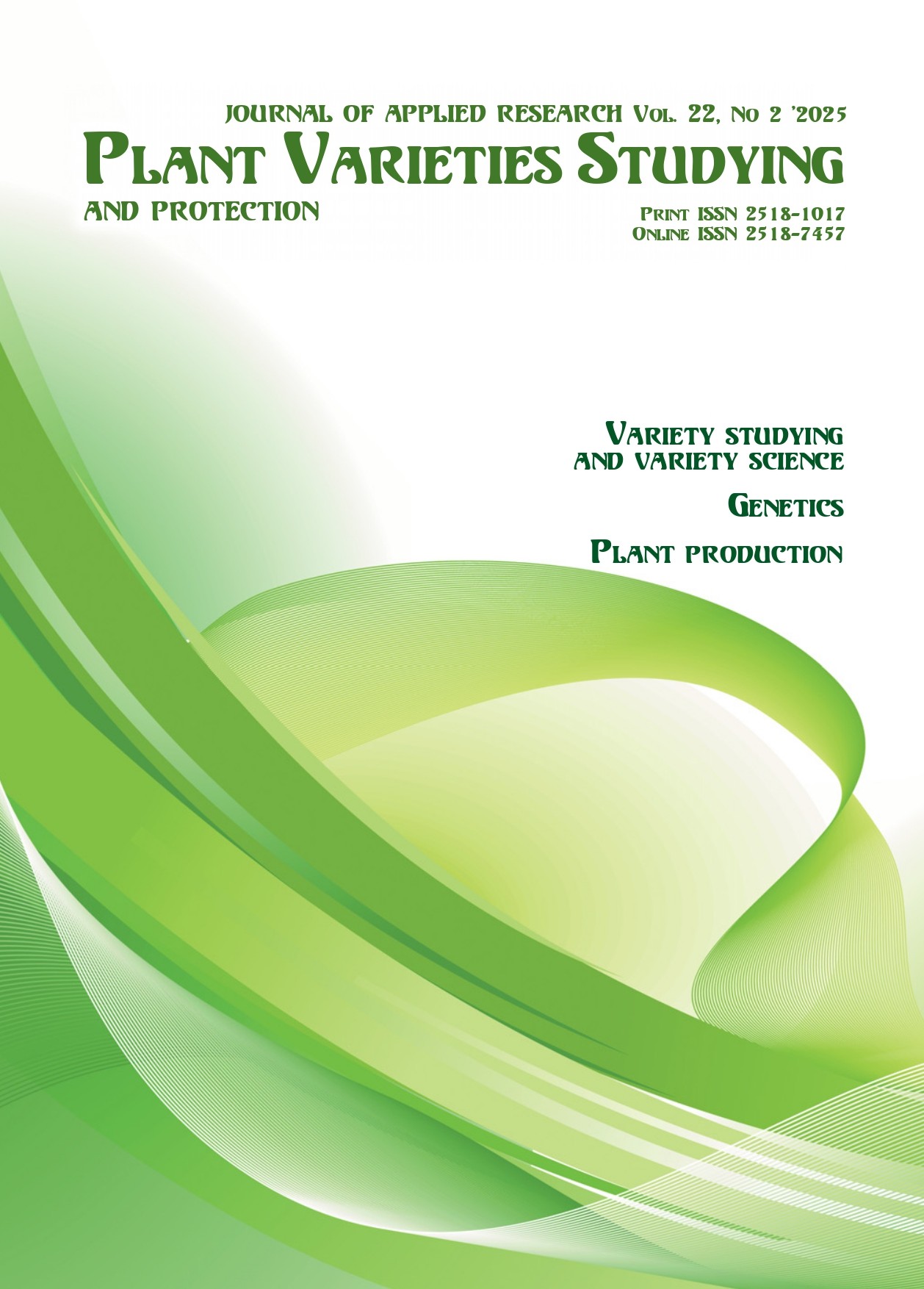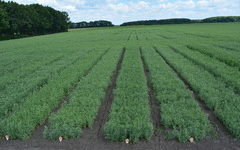The potential of durum winter wheat cultivars in Ukraine
DOI:
https://doi.org/10.21498/2518-1017.21.2.2025.337399Keywords:
Durum winter wheat varieties, plant breeding, grain quality, cultivars replacementAbstract
Purpose. To highlight the durum winter wheat breeding results at the Plant Breeding and Genetics Institute – National Center of Seed and Cultivar Investigation (PBGI – NCSCI) during many years. Methods. Multiple both intraspecific and interspecific (with varieties and forms of common wheat) hybridization, including introgressive hybridization to create certain desired genotypes. Evaluation of the created lines and hybrids by a number of biological and economic characteristics, including the resistance to frost (winter hardiness), drought and main diseases, as well as protein content in the grain and its vitreousness. Results. There were 6 durum winter wheat cultivars replacement in Ukraine during past 65 years, with the leading role in the assortment belonging to cultivars created at the PBGI – NCSCI. The creation of varieties was focused on the introgression of dwarfism genes and alleles with low photoperiod sensitivity, improving floral fertility, increasing resistance to biotic and abiotic stresses. New cultivars (the sixth cultivars replacement) belong to the varieties of durum winter wheat leucurum (‘Lainer’, ‘Shliachetnyi’, ‘Blyskuchyi’, ‘Almaznyi’, ‘Yantarnyi’, ‘Kryshtalevyi’, ‘Zolotystyi’, ‘Marmurovyi’, ‘Sriblastyi’), hordeiforme (‘Areal Odeskyi’, ‘Hranatovyi’) and leucomelan (‘Prestyzhnyi’, ‘Yaskravyi’). All of them are cultivars of intensive type and universal use which are characterized by high resistance to lodging, drought and the most common diseases and average or above average frost resistance. Their grain has high vitreousness and high or above average protein content. Conclusions. Today, in the agricultural production of the steppe and forest-steppe zones of Ukraine, the most common cultivars of hard winter wheat of the fifth cultivars replacement are well established and therefore the most widespread: ‘Hardemarin’, ‘Burshtyn’, ‘Kontynent’, ‘Kreiser’, ‘Linkor’ and ‘Bosfor’. New varieties (sixth cultivars replacement) are also gradually spreading: ‘Areal Odeskyi’, ‘Liner’, ‘Prestyzhnyi’, ‘Shliakhetnyi’, ‘Blyskuchyi’, ‘Yaskravyi’, ‘Almaznyi’, ‘Yantarnyi’, ‘Kryshtalevyi’, ‘Hranatovyi’, ‘Marmurovyi’, ‘Zolotystyi’ and ‘Sribliastyi’ which belong to the selection of the Plant Breeding and Genetics Institute – National Center of Seed and Cultivar Investigation.
Downloads
References
World Food and Agriculture – Statistical Pocketbook 2021. (2021). FAO. https://doi.org/10.4060/cb4478en
Durum wheat: popular cultivars and growing peculiarities. (2024). http://tetra.agro.com.ua [In Ukrainian]
Pabriani, G., & Idntae, C. (1988). Durum wheat: chemistry and technology. American Association of Cereal Chemists.
Mastromatteo, M., Danza, A., Lecce, L., Spinelli, S., Lampignano, V., Laverse, J., Contò, F., & del Nobile, M. A. (2014). Effect of durum wheat varieties on bread quality. International Journal of Food Science and Technology, 49(1), 72–81. https://doi.org/10.1111/ijfs.12276

Palamarchuk, A. I. (2000). Economic and biological characteristics of new high-yielding cultivars of durum winter wheat and peculiarities of its cultivation in the steppe zone of Ukraine. Storage and Processing of Grain, 2, 9–11. [In Ukrainian]
Turki, N., Harrabi, M., & Okuno, K. (2012). Effect of salinity on grain yield and quality of wheat and genetic relationships among durum and common wheat. Journal of Arid Land Studies, 22(1), 311–314.
Tidiane, Sall A., Chiari, T., Legesse, W., Seid-Ahmed, K., Ortiz, R., van Ginkel, M., & Bassi, F. M. (2019). Durum Wheat (Triticum durum Desf.): Origin, Cultivation and Potential Expansionin Sub-Saharan Africa. Agronomy, 9(5), Article 263. https://doi.org/10.3390/agronomy9050263

State standard of Ukraine (DSTU) 3768:2019: Wheat. Technical conditions (2020). Derzhspozhyvstandart Ukrainy. [In Ukrainian]
Trybel, S. O. (Ed.). (2010). Methodology for assessing the resistance of wheat varieties to pests and pathogens. Kolobih. [In Ukrainian]
Palamarchuk, A. I. (2012). Effectiveness of the breeding program for winter durum wheat. Collection of scientific papers of the Plant Breeding & Genetics Institute – National Center of Seeds and Cultivar Investigation, 20, 44–55. [In Ukrainian]
Álvaro, F., Isidro, J., Villegas, D., García del Moral, L. F., & Royo, C. (2008). Old and modern durum wheat varieties from Italy and Spain differ in main spike components. Field Crops Research, 106(1), 86–93. https://doi.org/10.1016/j.fcr.2007.11.003

Palamarchuk, A. I. (1990). Breeding of intensive type durum winter wheat varieties to increase adaptation potential. In Proceedings of International Symposium “Wheat Breeding-Prospects and Future Approaches” (pp. 71–75). Albena, Bulgaria, Institute for Wheat and Sunflower.
Palamarchuk, A. I. (2013). Yield potential and grain yield stability in durum winter wheat varieties in Ukraine. In Proceedings of International Symposium “Genetics and Breeding of Durum Wheat” (p. 51). Rome, Italy.
Ivanisova, A., Marchenko, D., Kostylenko, O., Dubinina, O., & Antonenko, L. (2023). Studying varieties of winter durum wheat in interstation test on economic and valuable features. E3S Web of Conferences, 413, Article 01007. https://doi.org/10.1051/e3sconf/202341301007

Gyrka, A. D., Gasanova, I. I., Gyrka, T. V., & Bokun, O. I. (2018). Growth, development and productivity of winter wheat depending on the soil tillage and sowing systems. Grain Crops, 2(1), 88–93. https://doi.org/10.31867/2523-4544/0012
Korkhova, M., Panfilova, A., Domaratskiy, Y., & Smirnova, I. (2023). Productivity of winter wheat (T. aestivum, T. durum, T. spelta) depending on varietal characteristics in the context of climate change. Ecological Engineering and Environmental Technology, 24(4), 236–244. https://doi.org/10.12912/27197050/163124

Budzyński, W. S., Bepirszcz, K., Jankowski, K. J., Dubis, B., Hłasko-Nasalska, A., Sokólski, M. M., Olszewski, J., & Załuski, D. (2018). The responses of winter cultivars of common wheat, durum wheat and spelt to agronomic factors. The Journal of Agricultural Science, 156(10), 1163–1174. https://doi.org/10.1017/S0021859619000054

Melnyk, T. V., Yarchuk, I. I., & Masliiov, S. V. (2019). Efficiency of cultivation of hard winter wheat of variety Kontynent in conditions of the northern Steppe of Ukraine. Grain Crops, 3(1), 45–51. https://doi.org/10.31867/2523-4544/0059
State register of plant varieties suitable for dissemination in Ukraine. (2025). https://minagro.gov.ua/file-storage/reyestr-sortiv-roslin [In Ukrainian]
Published
How to Cite
Issue
Section
License
Copyright (c) 2025 A. I. Palamarchuk, V. F. Kodzhebash

This work is licensed under a Creative Commons Attribution-ShareAlike 4.0 International License.
Starting in 2022, the copyright to the publication remains with the authors
Our journal abides by the CREATIVE COMMONS copyright rights and permissions for open access journals.
Authors, who are published in this journal, agree to the following conditions:
- The authors reserve the right to authorship of the work and pass the first publication right of this work to the journal under the terms of a Creative Commons Attribution License, which allows others to freely distribute the published research with the obligatory reference to the authors of the original work and the first publication of the work in this journal.
- The authors have the right to conclude separate supplement agreements that relate to non-exclusive work distribution in the form in which it has been published by the journal (for example, to upload the work to the online storage of the journal or publish it as part of a monograph), provided that the reference to the first publication of the work in this journal is included.

























 Ukrainian Institute for Plant Varieties Examination
Ukrainian Institute for Plant Varieties Examination  Селекційно-генетичний інститут
Селекційно-генетичний інститут Institute of Plant Physiology and Genetics of the National Academy of Sciences of Ukraine
Institute of Plant Physiology and Genetics of the National Academy of Sciences of Ukraine
 The National Academy of Agrarian Sciences of Ukraine
The National Academy of Agrarian Sciences of Ukraine